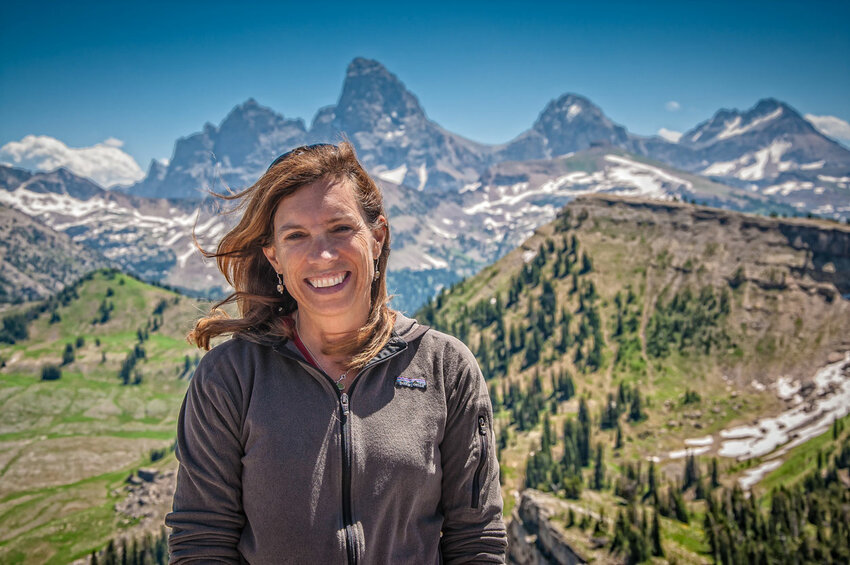By Molly Absolon | PREVIEW Columnist

Bear 399 and four cubs.
My neighbor is famous.
She has 50,000 followers on Facebook and a recent post on her page there had 4,200 likes, 250 comments and 400 shares within a day. When you Google her, roughly 125 million results come up. Born in 1996, she has had 18 children, including quadruplets born in 2020. She is Bear 399, the most famous grizzly in the Northern Rockies.
I’ve seen videos of Bear 399 and her offspring, including one from a security camera at the police station in downtown Jackson, Wyo., that showed five large bears strolling down a city street. But I’ve never seen the family in person. I’d like to, but part of me believes it’s my responsibility as a wildlife lover not to try to find her.
People were looking for her this spring. They knew where she’d denned and, so, when the famous five emerged in Grand Teton National Park, 15 to 20 cars were waiting. Word spread quickly, and soon roughly 100 vehicles lined the road to catch a glimpse of the group.
The bears are undeniably cute. They have a rolling, pigeon-toed gait that is amusing to watch. The cubs frolic around mama while she continues on her way, ignoring their antics, but always watching to make sure they are near. Their faces are expressive, their bodies roly-poly and cuddly. They play like kids with a harried mother who is slightly overwhelmed by her disorderly brood.
But therein lies a problem. Wildlife biologists have chosen not to name animals they study, instead giving them numbers for identification lest we anthropomorphize them. But that hasn’t worked for 399.
Her life story and personality has made her beloved by people all over the world, and especially in her home around Jackson Hole. She seems to be used to the human attention. We relate to her life, her children and her adventures, ignoring that she is a wild grizzly bear. We forget that she can be as dangerous to us as we are to her.
Hilary Cooley, the grizzly bear recovery coordinator for the U.S. Fish and Wildlife Service, said at a meeting of state and federal wildlife and land managers last August, “The future’s not bright for these guys. They’ve been in a lot of trouble.”
During the quadruplets’ lives, they’ve gotten into livestock feed, human garbage and backyard beehives. In 2020, that happened five times. In 2021, it was 17 times, according to the Fish and Wildlife Service. They’ve walked through neighborhoods and they often cross highways. They’re around popular trails where people hike, bike and run.
399 had one encounter with a hiker in 2007 when the man — a friend of mine from Lander — stumbled upon her with her cubs feeding on an elk carcass. My friend doesn’t blame 399 for attacking him, which caused some nasty bites. Still, it was a scary experience, and that’s what seems to be missing in the media frenzy over 399.
She’s not a toy. She’s not a person. She’s an unpredictable, large, omnivorous, intelligent animal that has discovered she can find easy food near humans and continues to teach her children that skill.
We’ve probably all heard the expression, “A fed bear is a dead bear.” Studies show that eating human food or trash can turn a wild bear into a food-conditioned one. Suddenly the animal, which relies on a varied diet to maintain adequate weight for survival, has a new, easily accessible yummy food source: from a garbage can, a birdfeeder or a beehive. These bears grow less wary of humans and, over time, often become aggressive.
To its credit, Teton County, Wyo., has updated its land-development regulations. Beginning in July, residents will be asked to bear-proof garbage containers, livestock feed, birdfeeders, compost and beehives.
Still, Cooley, who works to save grizzlies, is not optimistic. She’s told reporters she thinks it’s likely one, two,or all of the family will have serious conflicts with humans during their lifetimes, leaving wildlife managers with a narrow range of options. And, to compound the problem, the family has moved south out of the park, toward trouble.
People can do a lot to help prevent this. For me, it means remembering that 399 is wild. It means not hopping into my car to go join the bear jam. It means making sure my property or my campsite is bear-proof. It means carrying bear spray.
It means trying not to be part of the problem.

Molly Absolon is a contributor to Writers on the Range, writersontherange.org, a nonprofit dedicated to spurring lively conversation about the West. She writes in Wyoming.